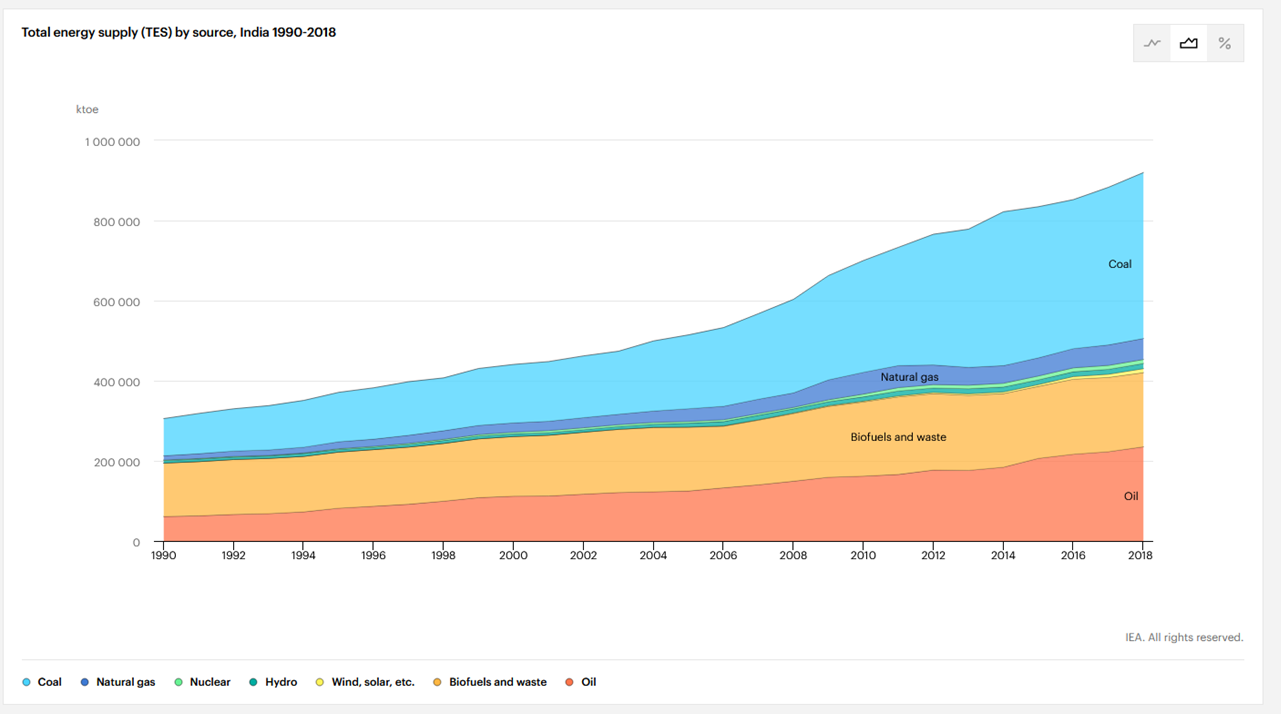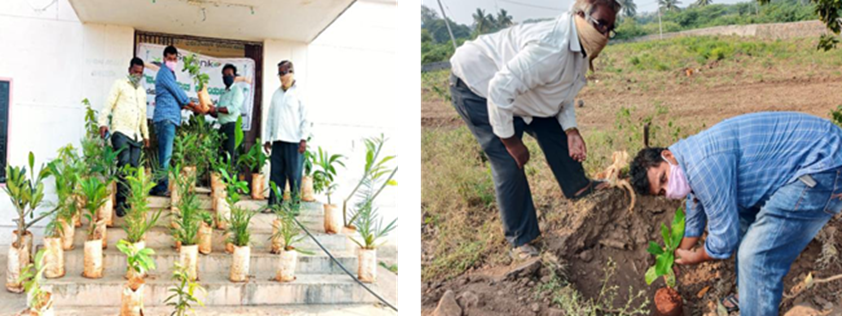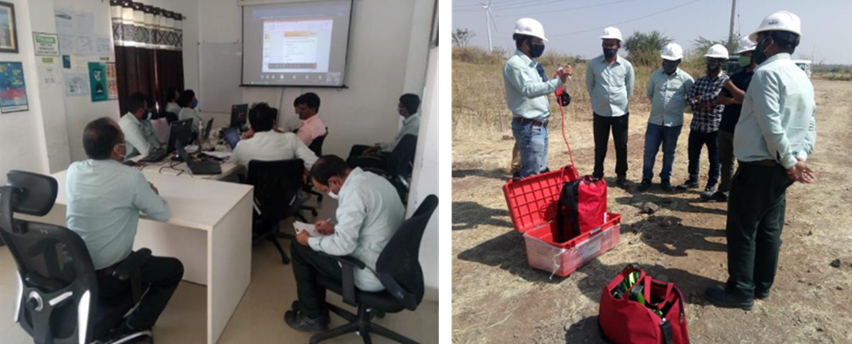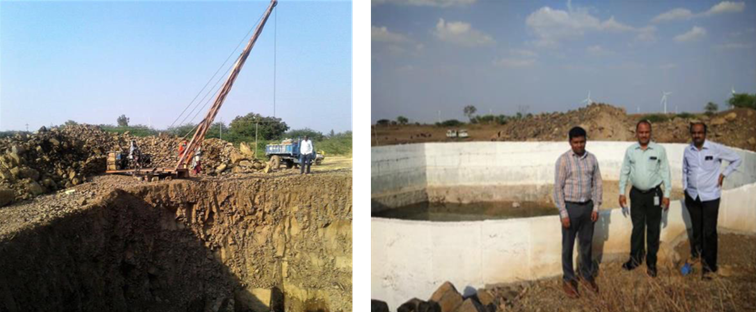
Devarahipparigi Wind Power Project
Karnataka, India
The primary objective of the Devarahipparigi Wind Power Project is the deployment and operation of 100GW of wind capacity in the Karnataka state of India. The project is grid-connected, so this means it delivers clean power to displace existing fossil fuel power. Over the lifetime of the project's reporting period, it will help avoid the release of 268,604 tonnes of CO2 emissions.
The project also aims to deliver localised co-benefits that align with the Sustainable Development Goals. These are as follows:
Goal 6 - Clean Water and Sanitation: from this project, 4,000 people from local villages will receive a clean drinking water supply
Goal 7 - Affordable and Clean Energy: during the monitoring period, 263,489MWh of renewable power is delivered to the grid.
Goal 8 - Decent Work and Economic Growth: A customised training programme for engineers and plant operators has been developed for workers on this project; skills which bolster the development of the low carbon supply chain in Karnataka.
Goal 13 - Climate Action: The avoidance of 268,604 tonnes of CO2!
Goal 15 - Life on Land: As part of the project, the developers have organised a plantation drive for the area, planting 1,300 tree saplings during the project monitoring period.

About the Devarahipparigi Wind Project
Mission
The purpose of the project is to enable the generation of energy by converting wind to electricity and selling it to the grid for consumption in homes, businesses and industry across the Karnataka.
Supporting the decarbonisation of India's grid is of global importance. To-date, around 75% of India's electricity mix is from fossil fuels, the power system is responsible for around 50% of the country's total emissions (2.5 billion tonnes per year), and is the third dirtiest in the world (after Poland and South Africa).
As the generation of renewable power from wind and solar does not require the burning of any fossil fuels, it can start to curb India's runaway annual CO2 emissions. The financing of these projects is critical in helping them scale-up and displace existing fossil fuel. The estimated annual average GHG emission reductions from the project activity will be 268,604 tonnes of CO2.
Carbon offsets help make this project possible by providing the necessary financing to make these energy installations cost-competitive with legacy fossil fuel technology in the region. This 'additionality' of carbon offsetting is critical for supporting the early deployment of renewable energy. As low carbon solutions are more widely deployed in developing countries such as India, supply chains will be built, the workforce will be upskilled, and these solutions will being to proliferate across the country. Importantly, additionality is a prerequisite for the environmental integrity of any carbon credit, protecting the buyer’s claim to have enabled climate mitigation and underpinning the integrity of offsetting and other financial claims.
According to International Energy Agency data, just 4.23% of India's total energy supply came from solar and wind in 2018, despite the countries vast solar and wind resource, demonstrating the critical need to support the scaling of this technology immediately.

Co-benefits
The project has also allocated additional resources to provide localised co-benefits in the surrounding area, through a tree planting initiative and the installation of a well for local villagers.

The training provided by the project will be valuable for the continued growth of Karnataka's broader capacity and market for renewable energy. Without high-quality training that gives workers the opportunity to build their vocational experience, skills gaps can emerge and be a bottle-neck for deploying renewables at scale. Furthermore, giving local people the ability to participate in the low carbon sector can help boost their career prospects and improve economic security.

Why Offsetra chose this project
Supporting renewable energy projects in developing regions that help decarbonise the power system provides long-term low-carbon jobs, and builds local supply chains is critical for us achieve our global net zero targets. There is much work still to be done to get renewables deployed at the scale necessary, particularly in developing countries that have bottle necks in skills and supply chain development.
Incumbent fossil fuels still having the economies of scale to out-compete renewable technologies. By supporting these projects with carbon offsets, we can start to disrupt the fossil fuel generation with an additional revenue stream, which ensures local people are not exposed to increasing costs or reduced accessibility to electricity!
Additionally, with the Devarahipparigi Wind Power Project, we loved the additional work that has been done to plant saplings, provide a supplementary training programme, and build an open well for the benefit of local villages. This is a great project to support from both the scale perspective (100GW is the biggest renewables project we've supported to date!), and for it's focus on the local community.
Economic Benefits
Fundamentally, the development of solar & wind projects leads to investment in the regions. This investment is additional and would not otherwise be achievable without the carbon projects. Through these interventions value is created at the local level for the communities.

The project activity generates employment in the local area during the development, maintenance and decommissioning of projects. Development of these low-carbon skills and the supply chain will be critical for the workforce to be able to efficiently construct and maintain new projects as India scales-up the roll-out of renewables.
The generated electricity will be fed into the Southern Grid, thereby improving the stability and availability of power in India, which in turn provides new opportunities for the development of industry and economic activity in the region to improve local employment and development opportunities.
The project activity also leads to diversification of the national energy supply, which is dominated by conventional fuel based generating units. Diversification of the national energy supply increases resilience of the power system and national energy security.
Use of renewable energy source also helps the conservation of natural resources (like coal) in the country, reducing mining and degradation of the land (reductions of GHG emissions in the atmosphere!) - in 2019, India produced 728 million metric tonnes of coal, a roughly 35% increase from 2012s output!
Social Benefits
Wind power locations do not need to be centralised in the way traditional fossil fuel plants are. The deployment of renewables can be distributed into various and numerous rural areas which have higher levels of unemployment and poverty. The project therefore supports the growth and development of rural and less well-connected regions.
The project increases the penetration of renewable power into the power system, reducing the risk of blackouts and supporting the connection of more homes to the grid. Around 5% of homes in India are still without a direct connection to electricity - that's over 130 million people going without power (or almost twice the population of the United Kingdom)
Climate
The climate of Karnataka ranges across the state, with the coastal regions the wettest, and further inland being driest.
Today, the Monsoon season is from June to September, but the state is expected to be impacted by climate change within the next decade, with warming and weaker Monsoon rains anticipated by 2030. Today, much of the agricultural land is rainfed rather than irrigated which could have serious implications for farming.
